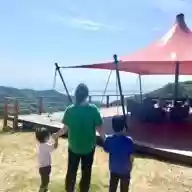A children's song from a popular fairy tale
There are many different fairy tales around the world.
In Japan, stories like Momotaro, The Rolling Rice Ball, and The Tortoise and the Hare are famous—many children today probably know them too, don’t you think?
In this article, we’ll introduce songs based on popular fairy tales!
Momotaro is well known as a song, of course, but did you know there are many other songs based on fairy tales as well?
If you’re thinking, “I don’t know them” or “I’ve never heard them,” this is the perfect chance to give them a listen.
Kids will be delighted to find out they can sing their favorite fairy tales!
They’re all wonderful songs that make the stories easy to understand.
Popular children's fairy tale songs (1–10)
The Rolling Rice BallFuyuki Ishigeta

The folktale Omusubi Kororin is quite famous, but did you know there’s a song for it? The song follows the storyline of the tale, so even those who don’t know the story can enjoy it while grasping the flow.
If you sing the song while doing a picture-story show or a puppet show, kids will have even more fun—so moms and teachers, give it a try.
The rhythm is lively and easy to remember, making it great for children to imitate and hum along to right away.
If there are kids who know the story but haven’t heard the song yet, please teach them this song together with the tale.
Come see me, Little Red Riding Hood!Kero Pons, Ryuzo Fukuda, Tsubasa Suzuki

Here’s a song that playfully sings the fairy tale Little Red Riding Hood from a fun, pop perspective, titled “Come See Me, Little Red Riding Hood!” Rather than a traditional tale, it feels more like an anime with a pleasant rhythm and lyrics sprinkled with modern expressions.
Even the wolf’s appearance isn’t scary at all, and there’s a sing-along section, making it super approachable.
It’s a powerful, happy piece overflowing with energy that lifts not only kids but adults too.
Urashima Tarorainbow moon

Many old tales end with “they lived happily ever after,” but some people seem to dislike this story because it ends poorly.
This piece stays faithful to the content of the Urashima Taro legend.
It vividly depicts the glittering splendor of the Dragon Palace, so please be sure to let them listen to it!
Daikoku-samaTAMURA Torazō

This is a children’s song about the Japanese myth of the Hare of Inaba.
The song’s title is “Daikoku-sama,” but the figure who appears in the original myth is Ōkuninushi, the enshrined deity of Izumo Taisha.
Daikokuten is a Buddhist guardian deity with roots in Hinduism, and it seems to have syncretized with Ōkuninushi because their names sound the same.
MomotaroTeiichi Okano

This is a song that turns the famous folktale Momotaro into music, and little children love it.
I think most people know the first verse, but there are actually lyrics up to the second verse.
The second verse is quite intense, so it seems that people mostly only sing up to the first verse, but singing just the first verse is enough for everyone to enjoy.
The Hare and the TortoiseBenjiro Nadosho

Do you know the famous fable “The Tortoise and the Hare,” in which a fast hare and a slow tortoise compete? This is a children’s song based on that story.
In the race, the hare, overconfident in its speed, ends up losing to the tortoise.
The tortoise, who doesn’t give up and bravely faces a seemingly unbeatable opponent, is a true hero to children!
Hanasaka Jiisan (The Old Man Who Made Flowers Bloom)TAMURA Torazō

This song is the one that sings about the famous folktale “Hanasaka Jiisan.” It’s an easy-to-understand story even for children: when it’s the honest old man, gold coins appear, but when it’s the mean old man, no coins come out.
It lets children feel that “good things happen when you’re honest!”





